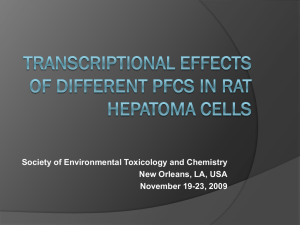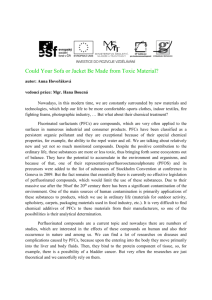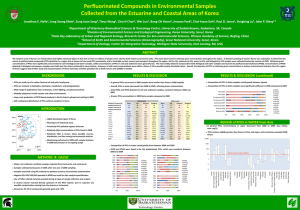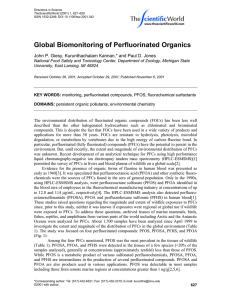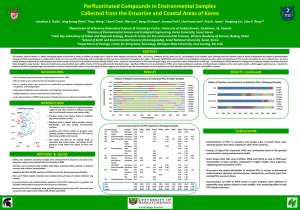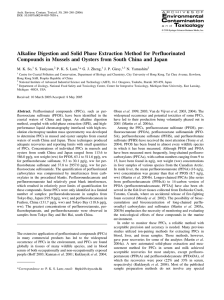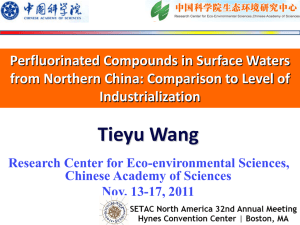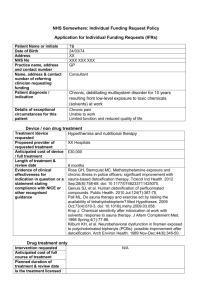C:\web sites\PDF_Test\pdf\1010.pdf
advertisement
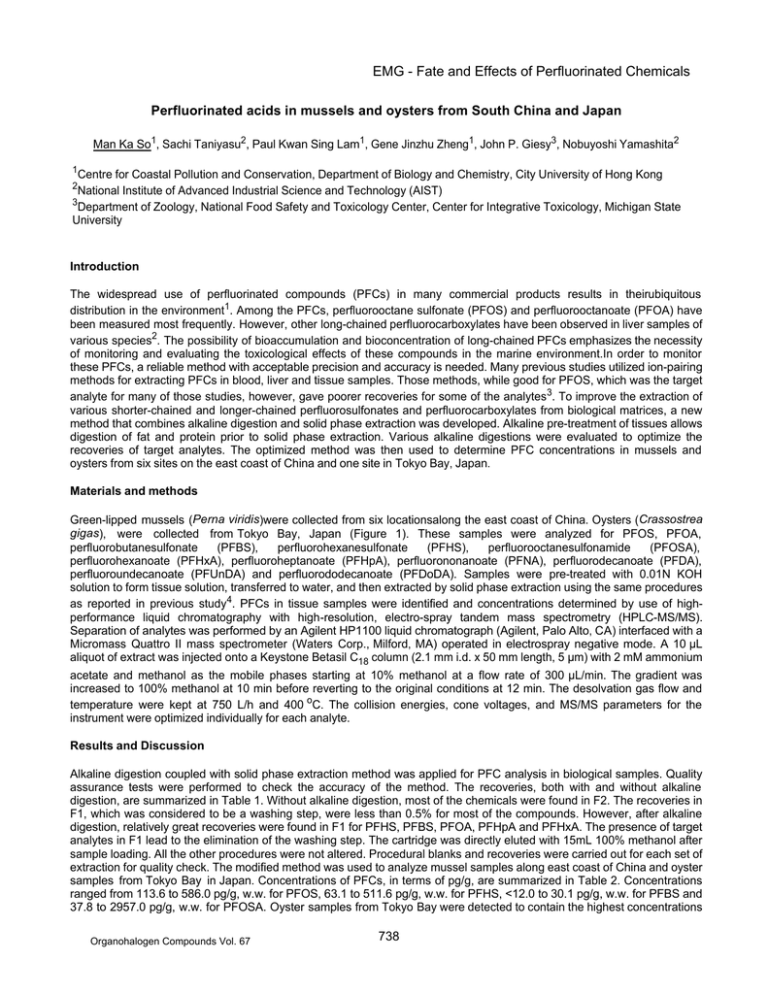
EMG - Fate and Effects of Perfluorinated Chemicals C:\web sites\PDF_Test\pdf\1010.pdf Perfluorinated acids in mussels and oysters from South China and Japan Man Ka So1, Sachi Taniyasu2, Paul Kwan Sing Lam1, Gene Jinzhu Zheng1, John P. Giesy3, Nobuyoshi Yamashita2 1 Centre for Coastal Pollution and Conservation, Department of Biology and Chemistry, City University of Hong Kong National Institute of Advanced Industrial Science and Technology (AIST) 3 Department of Zoology, National Food Safety and Toxicology Center, Center for Integrative Toxicology, Michigan State University 2 Introduction The widespread use of perfluorinated compounds (PFCs) in many commercial products results in theirubiquitous distribution in the environment1. Among the PFCs, perfluorooctane sulfonate (PFOS) and perfluorooctanoate (PFOA) have been measured most frequently. However, other long-chained perfluorocarboxylates have been observed in liver samples of various species2. The possibility of bioaccumulation and bioconcentration of long-chained PFCs emphasizes the necessity of monitoring and evaluating the toxicological effects of these compounds in the marine environment.In order to monitor these PFCs, a reliable method with acceptable precision and accuracy is needed. Many previous studies utilized ion-pairing methods for extracting PFCs in blood, liver and tissue samples. Those methods, while good for PFOS, which was the target analyte for many of those studies, however, gave poorer recoveries for some of the analytes3. To improve the extraction of various shorter-chained and longer-chained perfluorosulfonates and perfluorocarboxylates from biological matrices, a new method that combines alkaline digestion and solid phase extraction was developed. Alkaline pre-treatment of tissues allows digestion of fat and protein prior to solid phase extraction. Various alkaline digestions were evaluated to optimize the recoveries of target analytes. The optimized method was then used to determine PFC concentrations in mussels and oysters from six sites on the east coast of China and one site in Tokyo Bay, Japan. Materials and methods Green-lipped mussels (Perna viridis)were collected from six locationsalong the east coast of China. Oysters (Crassostrea gigas), were collected from Tokyo Bay, Japan (Figure 1). These samples were analyzed for PFOS, PFOA, perfluorobutanesulfonate (PFBS), perfluorohexanesulfonate (PFHS), perfluorooctanesulfonamide (PFOSA), perfluorohexanoate (PFHxA), perfluoroheptanoate (PFHpA), perfluorononanoate (PFNA), perfluorodecanoate (PFDA), perfluoroundecanoate (PFUnDA) and perfluorododecanoate (PFDoDA). Samples were pre-treated with 0.01N KOH solution to form tissue solution, transferred to water, and then extracted by solid phase extraction using the same procedures as reported in previous study4. PFCs in tissue samples were identified and concentrations determined by use of highperformance liquid chromatography with high-resolution, electro-spray tandem mass spectrometry (HPLC-MS/MS). Separation of analytes was performed by an Agilent HP1100 liquid chromatograph (Agilent, Palo Alto, CA) interfaced with a Micromass Quattro II mass spectrometer (Waters Corp., Milford, MA) operated in electrospray negative mode. A 10 µL aliquot of extract was injected onto a Keystone Betasil C18 column (2.1 mm i.d. x 50 mm length, 5 µm) with 2 mM ammonium acetate and methanol as the mobile phases starting at 10% methanol at a flow rate of 300 µL/min. The gradient was increased to 100% methanol at 10 min before reverting to the original conditions at 12 min. The desolvation gas flow and temperature were kept at 750 L/h and 400 oC. The collision energies, cone voltages, and MS/MS parameters for the instrument were optimized individually for each analyte. Results and Discussion Alkaline digestion coupled with solid phase extraction method was applied for PFC analysis in biological samples. Quality assurance tests were performed to check the accuracy of the method. The recoveries, both with and without alkaline digestion, are summarized in Table 1. Without alkaline digestion, most of the chemicals were found in F2. The recoveries in F1, which was considered to be a washing step, were less than 0.5% for most of the compounds. However, after alkaline digestion, relatively great recoveries were found in F1 for PFHS, PFBS, PFOA, PFHpA and PFHxA. The presence of target analytes in F1 lead to the elimination of the washing step. The cartridge was directly eluted with 15mL 100% methanol after sample loading. All the other procedures were not altered. Procedural blanks and recoveries were carried out for each set of extraction for quality check. The modified method was used to analyze mussel samples along east coast of China and oyster samples from Tokyo Bay in Japan. Concentrations of PFCs, in terms of pg/g, are summarized in Table 2. Concentrations ranged from 113.6 to 586.0 pg/g, w.w. for PFOS, 63.1 to 511.6 pg/g, w.w. for PFHS, <12.0 to 30.1 pg/g, w.w. for PFBS and 37.8 to 2957.0 pg/g, w.w. for PFOSA. Oyster samples from Tokyo Bay were detected to contain the highest concentrations Organohalogen Compounds Vol. 67 738 EMG - Fate and Effects of Perfluorinated Chemicals of PFOS (586.0 pg/g, w.w.) and PFOSA (2957.0 pg/g, w.w.). Nevertheless, the level of PFOS (3850.2 pg/g, w.w.) was much less than the greatest PFOS concentration measured in oysters from Hog Point, Chesapeake Bay of United States 5 (1,10600 pg/g d.w.). The comparatively small concentrations of PFCs in mussels from China indicated that the east coast of China is probably not severely polluted by PFCs. The composition of perfluorinated sulfonic acids and sulfonamide were compared among different sampling locations (Figure 2). Similar compositions were found in mussels from Bei Hai, Seng Si Dao, Fang Cheng and Qingzhou. A completely different profile was observed in oysters from Tokyo Bay suggesting that sources of PFC contamination in Japan and China could be quite different. In Japan, the greater PFOSA concentration may be due to the extensive use of insecticide to control termites and ants. Among all the sulfonate compounds, PFOS occurred at the greatest concentration in samples from most of the locations. However, in Fuzhou, PFHS occurred at the greatest concentration among all the PFCs indicating that a source of PFHS contamination might exist in this area. The ion-pairing extraction method that has been used in many of the previous studies for PFC analysis in tissue samples was used in one of the fish carcasses. The recoveries calculated from spiked samples are given6 (Table 3). In general, our new alkaline digestion and solid phase extraction method was more rapid and simple than the ion pairing method. Furthermore the new method resulted in greater recoveries for some compounds, especially PFBS, PFHS and PFDoDA. Although acceptable recoveries were achieved for most of the target analytes, trace amounts of certain PFCs in the procedural blank restricted the applicability of this method to samples containing relatively high concentrations with respect to those compounds. Further work will be required to minimize the blank level by improving the solid phase extraction procedure. References 1. Kannan L., Koistinen J., Beckmen K., Evans T., Gorzelany J.F., Hansen K.J., Jones P.D., Helle E., Nyman M. and Giesy G.P. (2001) Environ Sci Technol. 35: 1593-1598. 2. Martin J.W., Smithwick M.M., Braune B.M., Hoekstra P.F., Muir D.C.G. and Mabury S.A. (2004) Environ Sci Technol. 38: 373-380. 3. Martin J.W., Kannan K., Berger U., Voogt P.D., Field J., Franklin J., Giesy J.P., Harner T., Muir D.C.G., Scott B., Kaiser M., Järnberg U., Jones K.C., Mabury S.A., SchroederH., Simcik M., Sottani C., Bavel B.V., Kärrman A., Lindström G. and Leeuwen S.V. (2004) Environ Sci Technol. 248A-255A 4. So M.K., Taniyasu S., Yamashita N., Giesy J.P., Zheng J., Fang Z., Im S.H., Lam P.K.S. (2004) Environ Sci Technol. 38:4056-4063 5. Kannan K., Hansen K.J., Wade T.L. and Giesy J.P. (2002) Arch Environ Contam Toxicol. 42: 313-318 6. Martin J.W., Mabury S.A., Solomon K.R. and Muir D.C.G. (2003) Environ Toxicol Chem. 22: 189-195 Organohalogen Compounds Vol. 67 739 EMG - Fate and Effects of Perfluorinated Chemicals Table 1: Recoveries (%) for individual PFCs with and without alkaline digestion. The values are mean + standard deviations Without alkaline digestion (n=2) Fraction 1 Fraction 2 PFOS 0 115.7±15.4 PFHS 0.1±0.1 104.8±8.0 PFBS 0.1±0 102.2±0.8 PFOSA 0.1±0 117.9±2.7 PFDoDA 0 73.5±1.8 PFUnDA 0.1±0 93.7±1.7 PFDA 0.1±0 108.2±1.9 PFNA 0.2±0 107.4±3.5 PFOA 0.5±0.2 109.6±1.4 PFHpA 0 111.6±5.6 PFHxA 0.2±0.1 100.4±5.0 Recovery (%) With alkaline digestion (n=2) Fraction 1 0.9±1.2 66.5±31.0 93.6±27.5 0.6±0.3 0.4±0.3 2.6±1.2 2.3±1.5 17.5±2.9 104.8±5.8 120.7±8.9 120.6±2.0 Fraction 2 Fraction 1+2 149.1±11.5 150.0±15.7 33.2±10.5 99.7±41.5 1.3±0.3 94.8±27.8 104.0±8.9 104.6±8.7 91.6±6.4 92.0±6.7 110.5±1.9 113.0±3.1 114.7±0.1 116.9±1.4 101.1±1.6 118.6±1.3 24.1±3.6 128.9±9.3 1.7±0.3 122.4±8.7 1.6±0.4 122.2±2.4 Table 2: Concentrations of PFCs (pg/g, wet weight) in mussel and oyster samples collected from East Chinese Coast and Tokyo Bay in Japan. The values are mean + standard deviations. Location Concentration (pg/g, wet weight) PFOS PFHS PFBS PFOSA PFDoDAPFUnDAPFDA PFNA PFOA PFHpA PFHxA FZ 197.7±45.9511.6±10.5<12.0 287.7±3.0 <102.0 <1260.0 131.7±5.1<1596.0<204.0 <300.0 <183.0 XI 166.8±37.363.1±22.1 <12.0 234.7±23.7<102.0 <1260.0 <114.0 <1596.0<204.0 <300.0 <183.0 QZ 352.1±25.2118.6±11.330.1±9.153.5±23.6 <102.0 <1260.0 <114.0 <1596.0<204.0 <300.0 <183.0 FC 137.6±13.0133.6±4.2 29.3±7.345.2±9.2 <102.0 <1260.0 <114.0 <1596.0<204.0 <300.0 <183.0 SS 128.8±17.798.0±15.4 18.9±5.537.8±12.9 <102.0 <1260.0 <114.0 <1596.0277.4±6.5 366.3±61.9310.2±66.9 BH 113.6±5.1 86.7±0.2 19.1±0.862.2±10.9 <102.0 <1260.0 <114.0 <1596.0328.2±13.6507.1±56.2346.9±44.3 TB 586.0 201.7 25.6 2957.0 195.9 <1260.0 118.6 <1596.0660.5 <300.0 233.7 Table 3: Recoveries (%) of individual PFCs by using alkaline digestion coupled with SPE and ion-pairing extraction method. PFOS PFHS PFBS PFOSA PFDoDA PFUnDA PFDA PFNA PFOA PFHpA PFHxA Present method 158.5 99.5 75.5 82.0 89.5 99.0 123.5 111.5 92.5 117.0 112.5 Recovery (%) Ion-pairing extraction method ~75 ~75 ~60 Not analyzed ~65 ~80 ~80 Not analyzed ~100 ~95 Not analyzed Organohalogen Compounds Vol. 67 740
